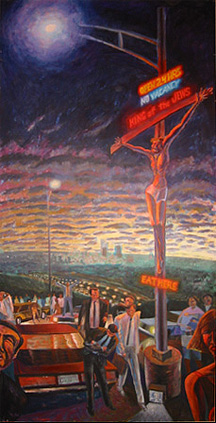In my last post I showed how some of what Jesus said about the Son of Man was drawn from Jewish speculation about the future. Even as Jewish visionaries in the time of Jesus looked forward to the coming of a glorious Son of Man who would judge the nations, so did Jesus (see Matt 25:31-32, 24:30). But, in addition, Jesus also spoke of the Son of Man in a completely unprecedented and shocking manner. (I have discussed this in depth in my book, Jesus Revealed. What follows in this post is a more succinct and edited version what I wrote in this book. Photo: A picture of Peter’s Confession from an old Sunday School curriculum. Thanks to http://thebiblerevival.com/.)
In one of the most dramatic scenes in the Gospel of Mark, Jesus asked his disciples who they thought he was. “You are the Messiah,” answered Peter, boldly (Mark 8:29). But then Jesus began to teach them that he, as the Son of Man, “must undergo great suffering, and be rejected by the elders, the chief priests, and the scribes, and be killed, and after three days rise again” (Mark 8:3). This revelation horrified Peter, who actually rebuked his master. Jesus responded with a stunning rebuke of his own, “Get behind me, Satan! For you are setting your mind not on divine things but on human things” (Mark 8:33).
At first glance we might scoff at Peter’s foolish audacity. But if we recall Daniel’s vision of the Son of Man, not to mention the development of this vision in later Jewish speculation, then we can begin to understand why Peter responded so negatively to Jesus’ prediction of his suffering as the Son of Man. Everything Peter believed up to that moment identified the Son of Man as the victor, not the victim. He was to be glorified, not crucified. He was to judge the gentiles, not to die under their judgment. Jesus was turning the image up the Son of Man completely upside down and Peter intended to save his master from such folly.
In another incident from the gospels, Jesus’ other closest followers, James and John, showed their confusion about Jesus’ role as Son of Man. When he again predicted his imminent suffering as the Son of Man, these two disciples couldn’t let go of their picture of his future triumph. They asked Jesus, “Grant us to sit, one at your right hand and one at your left, in your glory” (Mark 10:37). It’s as if they were saying, “All of this bizarre talk of suffering aside, we know that you’ll soon be enthroned as the Son of Man, and we want to get a piece of your glory for ourselves.” Jesus responded by explaining that they really didn’t know what they were asking. If, indeed, James and John sought to share in his work as the Son of Man, then they first had to share in his suffering.
When the rest of the disciples realized what James and John had asked, they became angry, presumably because they wanted to protect their own share of glory. Jesus reproved the whole group:
Whoever wishes to become great among you must be your servant, and whoever wishes to be first among you must be slave of all. For the Son of Man came not to be served but to serve, and to give his life a ransom for many (Mark 10:45).
The disciples expected Jesus to be the luminescent Son of Man, the one who would be served by all peoples, as prophesied in Daniel 7. Jesus, on the contrary, saw his initial mission as Son of Man as rendering service, not receiving it. Even more unexpected, he came to give up his very life for the sake of others.
Nothing in the disciples’ Jewish background had prepared them for this astounding claim concerning the mission of the Son of Man. Nowhere in Jewish thought prior to Jesus was the Son of Man envisioned as a servant who surrenders his own life for others. Where in the world did Jesus get this idea? Was it a brand new thought, a novel bit of special revelation? Or was Jesus drawing from some element of Jewish tradition that was not usually associated with the Son of Man?
I’m going to have to leave you with a cliffhanger today. Tomorrow I’ll explain how Jesus came up with the unprecedented notion of the serving, suffering Son of Man.

